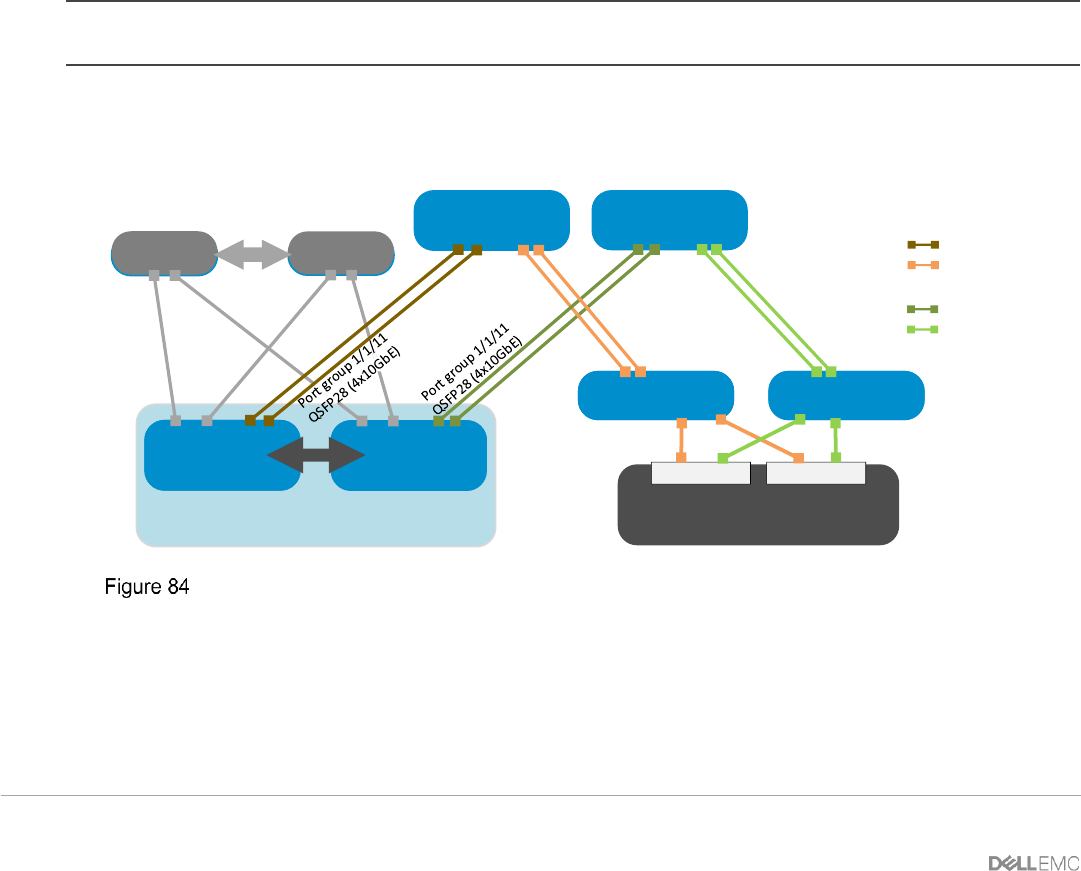Users Guide
Table Of Contents
- 1 Introduction
- 2 SmartFabric Services for PowerEdge MX: An overview
- 3 SmartFabric mode requirements, guidelines, and restrictions
- 3.1 Create multi-chassis management group
- 3.2 Upstream network requirements
- 3.3 VLAN scaling guidelines
- 3.4 Configuring port speed and breakout
- 3.5 Switch slot placement for SmartFabric mode
- 3.6 Switch-to-Switch cabling
- 3.7 NIC teaming guidelines
- 3.8 Maximum Transmission Unit (MTU) behavior
- 3.9 Other restrictions and guidelines
- 4 Creating a SmartFabric
- 4.1 Physically cable MX chassis and upstream switches
- 4.2 Define VLANs
- 4.3 Create the SmartFabric
- 4.4 Configure uplink port speed or breakout, if needed
- 4.5 Create Ethernet uplink
- 4.6 Configure Fibre Channel universal ports
- 4.7 Create Fibre Channel uplinks
- 4.8 Configuring the upstream switch and connect uplink cables
- 5 Deploying a server
- 6 SmartFabric operations
- 7 Switch operations
- 8 Validating the SmartFabric deployment
- 9 SmartFabric troubleshooting
- 9.1 Troubleshooting errors encountered for port group breakout
- 9.2 Troubleshooting Spanning Tree Protocol (STP)
- 9.3 Verify VLT/vPC configuration on upstream switches
- 9.4 Discovery of FEM and compute sleds
- 9.5 Troubleshooting uplink errors
- 9.6 Troubleshooting FC/FCoE
- 9.7 SmartFabric Services – Troubleshooting commands
- 10 Uplink configuration scenarios
- 10.1 Scenario 1 - SmartFabric deployment with Dell EMC PowerSwitch Z9100-ON upstream switches
- 10.2 Scenario 2 - SmartFabric connected to Cisco Nexus 3232C switches
- 10.3 Scenario 3: Connect MX9116n FSE to Fibre Channel storage - NPIV Proxy Gateway mode
- 10.4 Scenario 4: Connect MX9116n FSE to Fibre Channel storage - FC Direct Attach
- 10.5 Scenario 5: Connect MX5108n to Fibre Channel storage - FSB
- 10.6 Scenario 6: Configure Boot from SAN
- A Hardware used in this document
- B Dell EMC Unity information
- C Additional information
- D Validated components
- E Technical resources
- F Support and feedback

107 Dell EMC PowerEdge MX SmartFabric Configuration and Troubleshooting Guide
C140A1# show fc switch
Switch Mode : FPORT
Switch WWN : 10:00:e4:f0:04:6b:04:42
10.5 Scenario 5: Connect MX5108n to Fibre Channel storage - FSB
This chapter provides instructions for connecting either the MX5108n or MX9116n to a Fibre Channel SAN via
native FCoE uplinks. This connection type would be used in an environment where an existing switch such as
the Dell EMC PowerSwitch S4148U has the capability to accept native FCoE and connect to native FC.
Dell EMC SmartFabric OS10 uses a FIP Snooping Bridge (FSB) to detect and manage FCoE traffic and
discovers the following information:
• End nodes (E_Nodes)
• Fibre Channel forwarder (FCF)
• Connections between E_Nodes and FCFs
• Sessions between E_Nodes and FCFs
Using the discovered information, the switch installs ACL entries that provide security and point-to-point link
emulation to ensure that FCoE traffic is handled appropriately.
Note: The examples in this chapter use the Dell EMC Networking MX5108n. The same instructions may also be
applied and used with the MX9116n.
The FSB switch can connect to an upstream switch operating in NPG mode:
S4148U-ON
(NPG mode)
S4148U-ON
(NPG mode)
Unity 500F
MX5108n
FSB mode
(Leaf 2)
MX5108n
FSB mode
(Leaf 1)
VLT
MX7000 chassis
ToR switch 2
ToR switch 1
FC SwitchFC Switch
Unity 500F
Unity 500F
Controller A Controller B
VLT
FC SAN A
FC SAN B
FCoE SAN A
FCoE SAN B
FCoE (FSB) Network to Dell EMC Unity through NPG mode switch
Or operating in F_Port mode:










